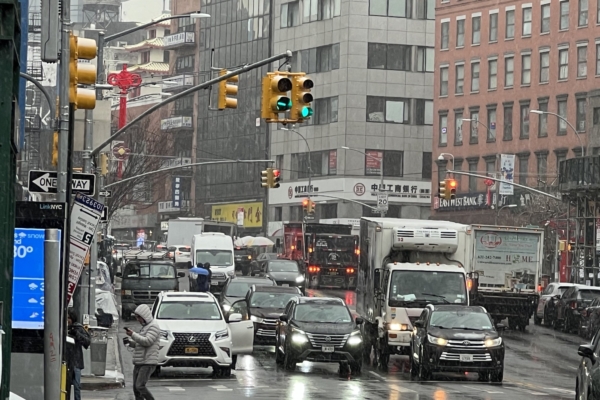On January 6 (Monday), the first workday after the implementation of the Manhattan congestion charge, many bus commuters found that there were fewer vehicles on the road, leading to improved commuting efficiency. However, some Chinese small business owners are feeling the pinch and expressing concerns about the challenges their businesses may face in the harsh winter ahead.
Following several rounds of litigation, the congestion charge policy was officially implemented last Sunday. Due to the storm affecting the area, on Monday morning, Manhattan was covered in snow, and there were fewer pedestrians in the business district south of 60th Street. Many Chinese bus commuters noted a significant decrease in traffic flow and a smoother bus operation. The Metropolitan Transportation Authority (MTA) is currently exempting commuter vehicles from the congestion charge, keeping ticket prices unchanged. Commuters are expressing satisfaction as they no longer have to worry about being late due to traffic congestion.
Mr. Yan, an Uber driver who picks up passengers across the suburban areas, received his first order to Manhattan on that day. Early Monday morning, he picked up a passenger from Manhasset on Long Island to Wall Street for a fare of over 80 dollars. “The customer was very pleased because there was no traffic, and we arrived in just 65 minutes. If there was traffic, it would have taken at least 20 minutes longer.”
He acknowledged that the congestion charge is now collected by Uber, making the process faster, but it also means less income for drivers from congestion-related fares. Customers always want to arrive at their destinations earlier and are willing to pay more for that convenience.
Mr. Yan also mentioned that “many trucks may start operating after 9 pm because the congestion charge during the day is higher.” As for whether truck drivers will shift to nighttime work, he believes it needs further observation since stores usually operate during the day and close at night.
Mr. Yan noted that he found MTA had already collected tunnel tolls through E-ZPass on Monday, but his electronic bill had not yet reflected the 9-dollar congestion charge. He mentioned that unlike other bridge tolls, MTA is expected to issue a weekly congestion charge bill for collection.
The implementation of the congestion charge, coupled with the cold and snowy Monday, left many Chinese businesses deserted, with some business owners fearing adverse impacts on future business operations.
Ms. Gu, the owner of a Chinese herbal medicine store, shook her head at the mention of the congestion charge: “Those of us in business oppose this. Customers who come to buy a ten-dollar medicine will now be charged an extra nine dollars. They will stop coming and go to Flushing or Brooklyn instead, where they can find the same things.”
Mr. Li, who has been operating a green potted plant store for 30 years, had almost no business in the entire morning. He feared his store may not survive this time, saying, “Just like today, all I can do is sit in the shop and scroll through my phone.”
Regarding the decrease in traffic flow due to the congestion charge, he believes it benefits wealthy individuals, saying, “This amount of money is nothing to them, their cars can move faster, but the cost is borne by people like us.” Since customers usually drive to buy potted plants and public transportation is inconvenient, he expressed readiness to close the store and prioritize his health in the future.
Nearby, a Chinese clothing store located near a subway station with usually many customers also experienced an unusual quietness on Monday. Mr. Zhou, the store owner, shook his head in disappointment, saying, “Business is slow, no one is coming to buy. Let’s wait for better weather.”
Ms. Zhou, a daily commuter to Manhattan, believes that the reduced traffic and pedestrian numbers on Monday in Manhattan could also be attributed to the just-ended New Year holiday, saying, “There are fewer tourists, which is also a factor.”
An observation by reporters found that compared to the past, the number of private cars passing through Manhattan’s commercial districts on Monday indeed decreased, but taxis and delivery trucks were still frequent.
Chinatown BID Executive Director Mr. Chen, who had been observing in Chinatown on both Sunday and Monday, noted that there were actually more people on Sunday compared to Monday, especially in the bustling restaurant hub of Chinatown’s commercial center.
Mr. Chen mentioned that some businesses will inevitably be affected, but he also pointed out that the current congestion charge has just been implemented. Stakeholders are conducting research and evaluating the impacts, emphasizing that the city’s development at this stage requires an adaptive adjustment period.
On Monday, large trucks were still frequently moving along Canal Street, the main road in Chinatown, which he considers as “an indicator of commercial activity.”
MTA Chairman and CEO Janno Lieber, in an interview with the media on Monday, stated that the comprehensive impact of the congestion charge will take time to become apparent.
Lieber explained that only 130,000 private vehicles enter the fee-charging zone, with 90% of people using public transportation. The goal of the congestion charge is to reduce traffic and vehicle volumes by 10-20%. The reduction of the charge from $15 to $9 aids in the smoother rollout of the plan, but the decrease in traffic flow may be weaker than anticipated in the beginning.

